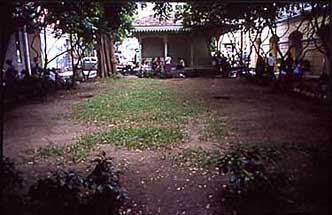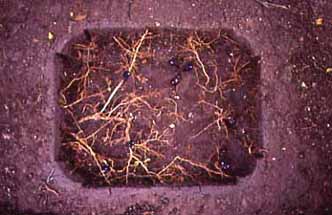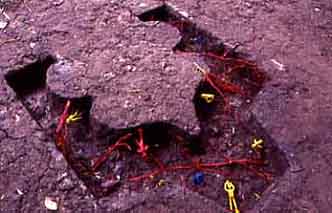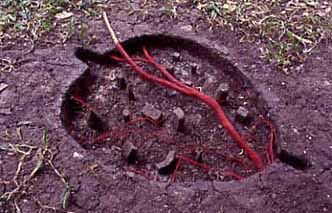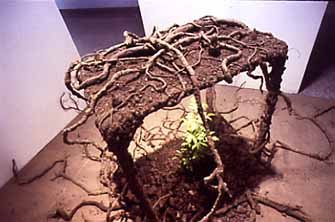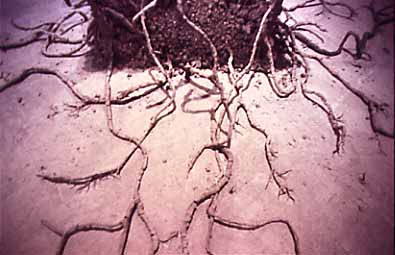The garden and adjacent pavilion at Silkaporn University were once used for performances for the
Thai Crown Prince and is now a space of intense social activity. This history was referenced by using shapes from the pavilion
fretwork as templates for a series of 'digs' in the garden which would
express the cultural and natural forms and energies of the site. Tree roots were revealed some of which were stained red like blood vessels.
Assistants were invited to place small models and figures in the excavated
spaces to create microcosms of city and jungle like landscapes, in what
became an archeology of fantasy and fact.
In addition a work was created in the nearby gallery using earth from the excavation to form a hypothetical root system. A seedling of the tree species in the garden was placed unde the table as a further marker. As this work was realised during the rainy season the natural processes
of erosion slowly dissolved the excavated shapes and the site was gradually
returned to its original state (Earth
from this installation was also returned to the garden after the exhibition
period).
Tharnrark (the Thai word for roots or foundations) was a collaborative work
created with Thai artist Kamol Phaosavasdi in an enclosed garden at Silpakorn
University as part of an International workshop/symposium. Both artists
have long been making works relating to ecology, environment, agriculture,
and nature etc. The project was initiated by New York based curator, Karen
Lim (Singapore) to address issues of cultural hybridity, mapping and the
convergence of art, architecture and archaeology, botany and history.
"Tharnrark reflected the artists’ personal philosophy
with regards to nature, environment and space. Time, patience and intricate
handwork were needed to perform the excavation of the site. The presence
of the roots was allowed to naturally form a visual language that revealed
depth and layering, in a kind of reversal of the constructive process
of painting and sculpture. Each dig revealed the idea of re-mapped sites
- once lost and now rediscovered, once reminisced and now fantasized. The process by which Tharnrark was constructed is equally
important to the appearance of the final work. The life of the space and its energy were
central to its unfolding as the artists and assistants enacted a kind
of community performance. The process throughout was informal and organic,
with resolution of material and conceptual concerns through negotiation
and dialogue. The artists remained flexible and were not working towards a pre-conceived outcome"
Karen
Lim, Curator |
